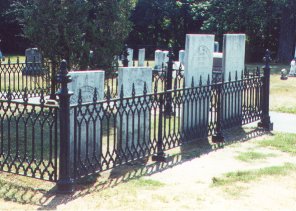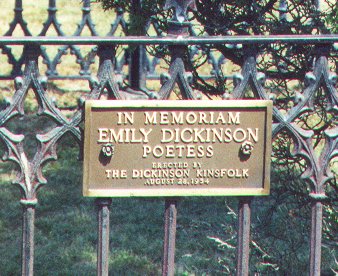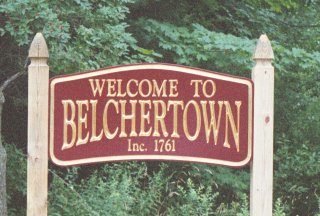| (This is the fifth in a series of pieces chronicling
my trip to Massachusetts and Vermont. It was written and posted after August
14 but dated the day it refers to. Subsequent pieces through August 11
will follow the same pattern.)
July 28, 2002
Sunday
But I did visit, early Sunday morning. The sky was a bit overcast and threatening, and I figured (rightly, it turned out) that the pilgrimage (with flowers and singing) set for the conclusion of the EDIS business meeting and luncheon might be cancelled. When Emily Dickinson died in 1883 she was well-known (for being not well-known) in the town of Amherst -- "Squire Dickinson's half-cracked daughter" is how a playwright has her describe herself. She was buried in the family plot beside her parents. When her sister Lavinia died in 1899 she too was laid to rest there. Brother Austin, who died in 1895, is in a different cemetery.
As 19th century cemeteries go Amherst's West Cemetery is adequate. It has some angels, some rows of small stones representing whole families of lost siblings, some crypts built into moss-covered banks. But it doesn't seem to have the fabulous ostentation (and thus architectural interest) of Boston's Mount Auburn or Reading's Charles Evans. The town of Amherst has fit itself around it. There's a small shopping center on the eastern edge visible from ED's grave and the sounds of traffic punctuate any pilgrim's walk through the grounds. So I paid my respects, spent about an hour looking at features of the Dickinson plot and sorrounding spots I hadn't bothered to notice before, and then headed for the "Share Your Research" session at the conference site. Writers and other artists often work in isolation. With academics, the subjects they teach can have nothing to do with their research projects. And some people who attend these conferences are not necessarily scholars dedicated to studying Emily Dickisnon only. In the "Share Your Research" session, participants are invited to say something about what they're interested in, what brought them to Dickinson and to this conference. The gathering provides an important opportunity for networking. The two dozen people who gathered in the lounge of the Amherst College Alumni House represented two dozen different avenues of endeavor -- writers, painters, language specialists, grief counselors, translators. I identified myself as a fiction writer and essayist with a special interest in the 19th century. I said that I was working on a historical novel and a biography of a 19th century Pennsylvania newspaperman, and that research into his work in Boston would be the next phase of my trip. And while I spoke a sudden conviction came over me that when I sit in this same session again in 2005, when the conference will next be in Amherst, I want to be able to say that I finished those projects and that I'm working on something else.
Cambridge/Boston is three hours east on Route 2. Massachusetts highways are different from those in Pennsylvania. They have a more rural quality, sometimes four-lane, sometimes narrowing to two-lanes with traffic lights near the towns, and there are no billboards. There was some heavy rain. Near Concord (15 or 20 miles from my destination) the traffic slowed, and then stopped for a bit. Ranged in a row behind me were three men on motorcycles. They had the stereotypical biker look -- leather jackets, bandanna, mirrored sunglasses. I became aware that they were discussing my license plate, "MAGY-MA." Biker #1: Look, it's Maggie May.
At that point I opened the door and yelled to them, "It's Maggy May!" They waved, and then sang, "Wake up Maggie, I think I got something
to say to you..." until the traffic began to move.
|
 No
visit to Amherst is complete without a stop at Emily Dickinson's grave.
I took the picture at left in 1999. I also have some pictures from my fist
visit in 1984. I didn't take any new pictures this time.
No
visit to Amherst is complete without a stop at Emily Dickinson's grave.
I took the picture at left in 1999. I also have some pictures from my fist
visit in 1984. I didn't take any new pictures this time.
 I
am told that the original stone which marked Emily Dickinson's spot was
small and said only "Emily." With the rise in her popularity through the
first half of the twentieth century her gravesite became a destination
for literary pilgrims. The daughters' stones were replaced with taller
ones that matched their parents', and the entire message from the last
letter Emily Dickinson wrote, "Called Back," was engraved on hers. "The
Dickinson Kinsfolk" (members of the extended family, as no direct descendents
of Squire Dickinson survived beyond 1943) enclosed the plot with an iron
fence and affixed the plaque seen at right in 1954.
I
am told that the original stone which marked Emily Dickinson's spot was
small and said only "Emily." With the rise in her popularity through the
first half of the twentieth century her gravesite became a destination
for literary pilgrims. The daughters' stones were replaced with taller
ones that matched their parents', and the entire message from the last
letter Emily Dickinson wrote, "Called Back," was engraved on hers. "The
Dickinson Kinsfolk" (members of the extended family, as no direct descendents
of Squire Dickinson survived beyond 1943) enclosed the plot with an iron
fence and affixed the plaque seen at right in 1954.
 I
am not good at farewells. I took my leave quickly of the people I'd known
before whose friendship and urging had convinced to make this trip and
of the people I'd come to know this weekend. I took the scenic route out
of town where I stopped for a photo of the most amusing "Welcome to" sign
in the area, seen at left.
I
am not good at farewells. I took my leave quickly of the people I'd known
before whose friendship and urging had convinced to make this trip and
of the people I'd come to know this weekend. I took the scenic route out
of town where I stopped for a photo of the most amusing "Welcome to" sign
in the area, seen at left.